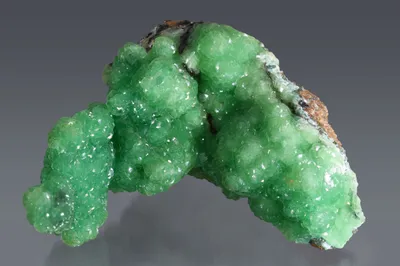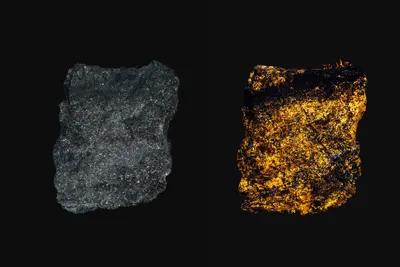Mineral Species
Greenockite
Type Locality
No
Composition
CdS
Crystal System
Hexagonal
Status at Tsumeb
Confirmed
Abundance
Very rare
Distribution
First, second and third oxidation zones; sulphide ores
Paragenesis
hypogene (?); supergene
Entry Number
Species; TSNB157
General Notes
Greenockite occurs as prismatic crystals to 1 mm on wurtzite from the first oxidation zone, as tiny ochre-coloured crystals on smithsonite in the second oxidation zone (Gebhard 1999) and as part of the type assemblage for sidpietersite in the third oxidation zone (Roberts et al. 1999).
Greenockite has been recognised at Tsumeb since the earliest days of mining (Schneider 1906). It occurs as somewhat rare and generally inconspicuous microcrystals associated with oxidising sulphides, notably sphalerite and galena. Tiny (commonly sub-mm) hexagonal barrel-shaped crystals, typically mustard-yellow in colour, occur on the surfaces of other sulphide minerals and on secondary minerals such as smithsonite. Some of these crystals are clearly of supergene origin.
Pinch and Wilson (1977) noted that greenockite "… forms fracture fillings and minute masses visible only under the microscope" and that "It has also been observed as a yellow to ochre-colored dusting on sphalerite and other minerals." They observed that as inclusions, greenockite can impart a yellow colour to anglesite, smithsonite and wurtzite.
Indeed, the colour of yellow, or yellow-brown smithsonite at Tsumeb is commonly attributed to cadmium, which is generally assumed to be in the form of microscopic inclusions of greenockite (or perhaps hawleyite); the name "cadmian smithsonite" is often used to describe specimens of such colour (e.g. Pinch and Wilson 1977; Gebhard 1999). However, a recent study of smithsonite geochemistry has indicated that the presence of included iron oxides and hydroxides (?) is a far more common cause of yellow, orange and brown colouration than included greenockite (Weall, T (2023); unpublished Honours thesis; University of Wollongong, Australia).
Gebhard and Schlüter (1995) noted that, at Tsumeb, greenockite occurs typically as a powdery yellow mineral on sphalerite, on other ore minerals or occasionally as inclusions in smithsonite to which they impart a yellow colouration. On an old specimen from the Mineralogical Museum in Hamburg (catalogue number not specified) they found columnar crystals of greenockite to 1 mm in length. They recalled that in 1978 Paul Keller had found similar crystals on fluorescent wurtzite, associated with smithsonite, pyrite and galena.
Roberts et al. (1999) noted the occurrence of greenockite on the type specimen for sidpietersite, which was recovered from the third oxidation zone.
A specimen labelled as "cadmium wurtzite" in the collection of the University of Canberra (catalogue number UC3248), now housed at Geoscience Australia, displays a deep carmine-red fluorescence under long wavelength UV radiation. The specimen was donated to the university in the early 1970s, courtesy of TCL mineralogist Bob Schedler but unfortunately the level from which it was collected was not recorded. A re-examination of this specimen by SEM/EDS has indicated that much of the "wurtzite" is in fact a Zn-rich greenockite (F. Keutsch and M. Southwood, unpublished data); further investigation is required.
Associated Minerals
anglesite; baileychlore; galena; quartz; sidpietersite; smithsonite; sphalerite; wurtzite; zincite


